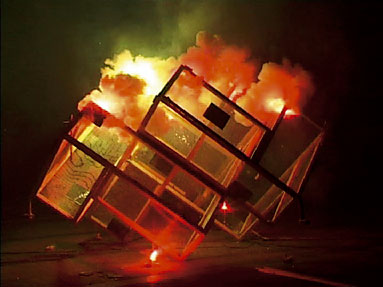|
Sandra Kranich was
born in 1971. She is an officially recognized pyrotechnician and creates
fireworks as art—beyond the call of her profession. As a form of
art, these eruptive events—to use that old metaphor for the male
orgasm—are related to other art forms. These events for the masses
developed as a form of princely entertainment during Rococo times, and
thanks to their rich colors remain highly popular. Of course, «color»—from
the point of view of painting—is naive. Kranich’s ground level
fireworks, which took place in March of this year, were limited to whites,
reds and greens, which intermingled as smoke. Monochromatic fireworks
are also imaginable, while there are more than 20 different shades of
gold. Unquestionably, fireworks are a decorative art form. But, as such,
it is independent and decorative only unto itself. Since the 1980’s,
painters have appreciated decoration because it protects painting from
the unreasonable expectation that it could express something that would
give it meaning. Decoration is decoration and nothing else. Kranich comes
more from a drawing background. Her dream is to create black fireworks
under a light sky. She is interested in the dynamics of lines. The fireworks
are shot into the sky, where they draw glistening lines which cross for
seconds and form a coincidental shape of independent forms; using new
precision fireworks («magic fire»), the height and time at
which they explode can be calculated precisely. Kranich wants to shoot
stereometric figures into the sky. In as much as the explosion of rockets
in space determines outlines, fireworks are related to sculpture. In the
broadest sense, the crashing and screaming bring them into the realms
of modern music, especially if one thinks of musicians who work with sound.
Crashing and lightning are like storms—performances that are simultaneously
both terrifying and beautiful. The colloquial expression «terribly
beautiful» conveys this impression. Yet, the sound is almost more
of an atmospheric accessory. The decisive relationship is that of the
fireworks to a performance. Each performance is unique, i.e. identical
and not repeatable. To paraphrase Walter Benjamin it is because fireworks
cannot be reproduced that they possess the aura that other forms of art
have lost, precisely because they can be reproduced. Fireworks are a collection
of intense moments, which is extinguished in a very short time and literally
dissipates into the night. It is the elements of fleetingness and the
long and complicated preparations for just a few moments of performance
that make these spectacles precious. Only the memory of them (and a documentary
video) remains. In an interview, the artist once said that one has to
learn how to see fireworks. She herself is able to see in slow-motion.
Sandra Kranich is the only female artist working in this field.
Burkhard Brunn
|
